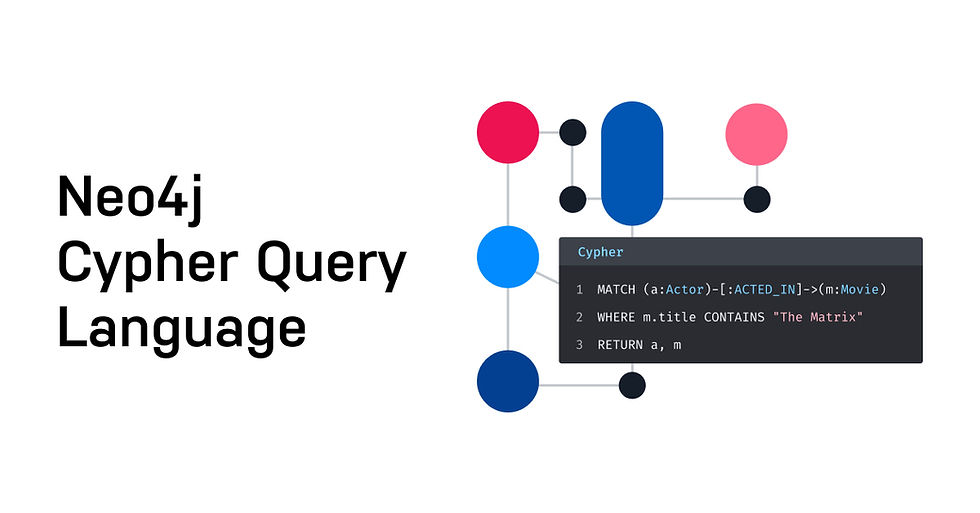
Welcome to a comprehensive guide on aggregation in Cypher! Aggregation allows you to summarize and analyze your graph data, helping you extract meaningful insights. In this demo, we'll explore various aggregation functions like count, average, min, and max and demonstrate their usage with practical examples.
Counting Nodes
Let's begin with one of the fundamental aggregation tasks: counting the number of nodes.
Example: Count the Number of Movies
In this example, we'll count the number of movie nodes in our database using the COUNT function. The result will be returned with the alias NumberOfMovies.
MATCH (m:Movie)
RETURN COUNT(m) AS NumberOfMoviesThis query returns the total number of movie nodes in the database.
Calculating the Average
Next, we'll use the AVG function to find the average of a numerical property across nodes.
Example: Find the Average Release Year of Movies
We'll calculate the average release year of all movie nodes using the AVG function. The result will be returned with the alias AverageReleaseYear.
MATCH (m:Movie)
RETURN AVG(m.released) AS AverageReleaseYearThis query provides a summary of the average release year for all movies.
Summing Values
Summing values can be useful for aggregating numerical data across nodes.
Example: Sum the Duration of All Movies
Here, we'll sum the duration of all movie nodes using the SUM function. The result is returned with the alias TotalDuration.
MATCH (m:Movie)
RETURN SUM(m.duration) AS TotalDurationThis query gives us the total duration of all movies in the database.
Finding Minimum and Maximum Values
Identifying the range of values in your data can be achieved using the MIN and MAX functions.
Example: Find the Earliest and Latest Release Years of Movies
We'll retrieve the earliest and latest release years of all movie nodes using the MIN and MAX functions, respectively. The results are returned with the aliases EarliestRelease and LatestRelease.
MATCH (m:Movie)
RETURN MIN(m.released) AS EarliestRelease, MAX(m.released) AS LatestReleaseThis query helps us identify the range of release years for movies in the database.
Grouping and Aggregating
Grouping and aggregating data is essential for summarizing information over categories.
Example: Group Movies by Release Year and Count the Number of Movies Released Each Year
We'll group movie nodes by their released year property and use the COUNT function to count the number of movies released each year. The results are returned with the alias MoviesPerYear and ordered by the release year.
MATCH (m:Movie)
RETURN m.released, COUNT(m) AS MoviesPerYear
ORDER BY m.releasedThis query provides a yearly breakdown of the number of movies released.
Grouping and Averaging
Combining grouping with averaging can help you understand trends within categories.
Example: Find the Average Rating of Movies by Genre
We'll group movies by their genre and calculate the average rating for each genre using the AVG function. The results are ordered by average rating in descending order.
MATCH (m:Movie)-[:HAS_GENRE]->(g:Genre)
RETURN g.name AS Genre, AVG(m.rating) AS AverageRating
ORDER BY AverageRating DESCThis query gives us the average rating of movies for each genre, helping to identify the highest-rated genres.
Finding the Actor with the Most Movies
Identifying key contributors in your data can be insightful for various analyses.
Example: Find the Actor Who Has Acted in the Most Movies
We'll match actor nodes and their related movie nodes, then count the number of movies each actor has acted in. The results are ordered by the number of movies in descending order, and the LIMIT clause is used to return only the top result.
MATCH (a:Person)-[:ACTED_IN]->(m:Movie)
RETURN a.name AS Actor, COUNT(m) AS NumberOfMovies
ORDER BY NumberOfMovies DESC
LIMIT 1This query helps us identify the actor who has appeared in the most movies.
Conclusion
In this demo, we've covered various aggregation functions in Cypher, including count, average, sum, min, and max. We've also seen how to group and aggregate data to extract meaningful insights. These aggregation techniques are powerful tools for summarizing and analyzing your graph data.
By mastering these aggregation techniques, you'll be well-equipped to analyze and interpret your graph data efficiently. Happy querying!
Comentários